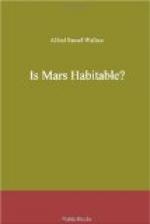In 1894, after a careful search for the best atmospheric conditions, Mr. Lowell established his observatory near the town of Flagstaff in Arizona, in a very dry and uniform climate, and at an elevation of 7300 feet above the sea. He then possessed a fine equatorial telescope of 18 inches aperture and 26 feet focal length, besides two smaller ones, all of the best quality. To these he added in 1896 a telescope with 24 inch object glass, the last work of the celebrated firm of Alvan Clark & Sons, with which he has made his later discoveries. He thus became perhaps more favourably situated than any astronomer in the northern hemisphere, and during the last twelve years has made a specialty of the study of Mars, besides doing much valuable astronomical work on other planets.
Mr, Lowell’s recent Books upon Mars.
In 1905 Mr. Lowell published an illustrated volume giving a full account of his observations of Mars from 1894 to 1903, chiefly for the use of astronomers; and he has now given us a popular volume summarising the whole of his work on the planet, and published both in America and England by the Macmillan Company. This very interesting volume is fully illustrated with twenty plates, four of them coloured, and more than forty figures in the text, showing the great variety of details from which the larger general maps have been constructed.
Non-natural Features of Mars.
But what renders this work especially interesting to all intelligent readers is, that the author has here, for the first time, fully set forth his views both as to the habitability of Mars and as to its being actually inhabited by beings comparable with ourselves in intellect. The larger part of the work is in fact devoted to a detailed description of what he terms the ‘Non-natural Features’ of the planet’s surface, including especially a full account of the ‘Canals,’ single and double; the ‘Oases,’ as he terms the dark spots at their intersections; and the varying visibility of both, depending partly on the Martian seasons; while the five concluding chapters deal with the possibility of animal life and the evidence in favour of it. He also upholds the theory of the canals having been constructed for the purpose of ‘husbanding’ the scanty water-supply that exists; and throughout the whole of this argument he clearly shows that he considers the evidence to be satisfactory, and that the only intelligible explanation of the whole of the phenomena he so clearly sets forth is, that the inhabitants of Mars have carried out on their small and naturally inhospitable planet a vast system of irrigation-works, far greater both in its extent, in its utility, and its effect upon their world as a habitation for civilised beings, than anything we have yet done upon our earth, where our destructive agencies are perhaps more prominent than those of an improving and recuperative character.
A Challenge to the Thinking World.




